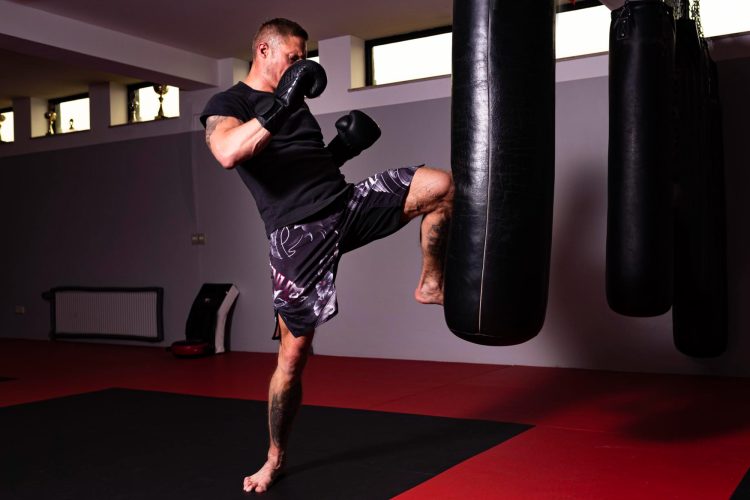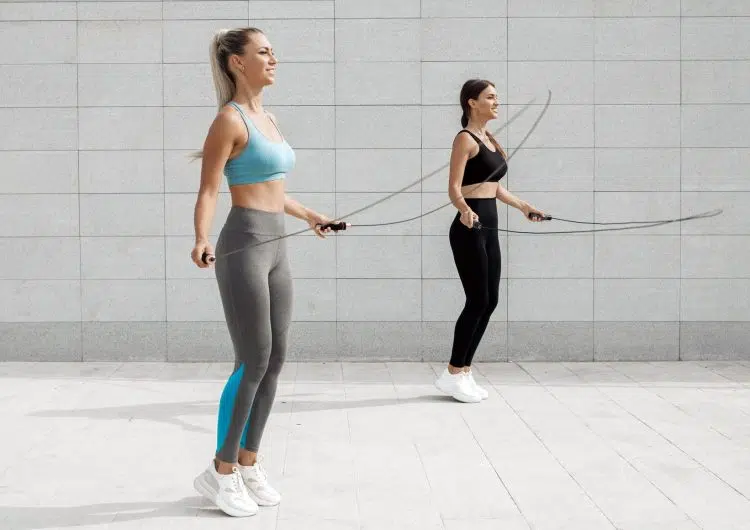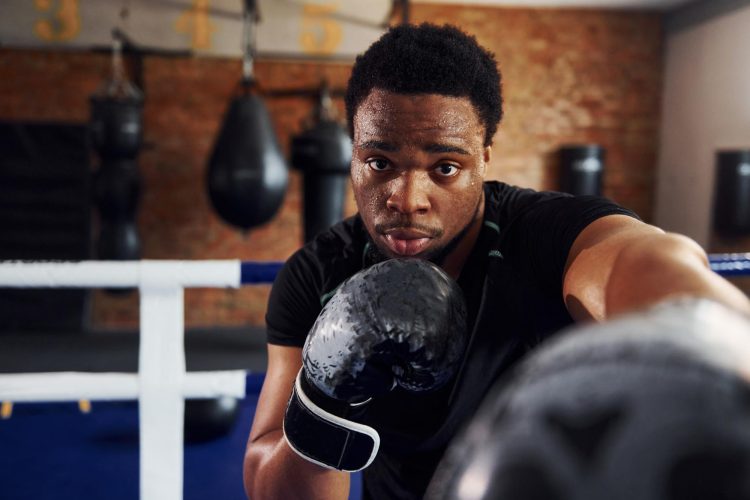Kickboxing, a combat sport, has been surging in popularity. It has lately become a frequent topic of conversation with my clients.
After all, kickboxing is a challenging yet fun and effective way to get in shape. A study published in the Muscles, Ligaments, and Tendons Journal showed that five weeks of kickboxing training can significantly improve aerobic and anaerobic fitness, muscle power, flexibility, and agility. (1)
That said, it can be intimidating to join a kickboxing gym, especially if you don’t have any prior martial arts experience. So, I decided to write this beginner’s guide to explain the basics of the sport, provide a sample workout to kickstart your journey and cover all the essentials you need to know.
Benefits of Kickboxing for Beginners

In my experience, clients show more commitment when they know about the benefits of kickboxing. It sets a positive tone right from day one.
Get Stronger
It shouldn’t come as a surprise that practicing a combat sport will make you stronger. To generate powerful kicks and punches, you must utilize almost every muscle in your body. It’s common to experience shoulder, core, arm, and leg soreness after the first session.
Level Up Your Fitness: Join our 💪 strong community in Fitness Volt Newsletter. Get daily inspiration, expert-backed workouts, nutrition tips, the latest in strength sports, and the support you need to reach your goals. Subscribe for free!
Improve Mobility, Coordination & Flexibility
All that kick- and punch-throwing, stance-switching, and footwork demand a ton of coordination, mobility, and flexibility.
For instance, when you throw a switch kick, you move your dominant hand in the opposite direction to counter the force and remain stable. With loads of other instances like this, your body will naturally adjust to these new movements, improving your overall physical fitness.
Boost Your Cardiovascular Health
Indulging in HIIT workouts, such as kickboxing, multiple times a week will do wonders for your cardiovascular health and conditioning. (2)
Gain Confidence
Few things boost confidence more than being strong, healthy, and capable of defending yourself. Getting just the kickboxing basics right can enhance your sense of self-worth.
Basics of Kickboxing
Understanding kickboxing starts with familiarizing yourself with the sport’s key elements.
Stance
A proper stance ensures stability, balance, and agility, optimizing your striking and defense.
As far as feet are concerned, you’d usually start with your feet hip-width apart and hips facing the opponent. From there, based on your dominant hand, you would assume either an Orthodox stance (right-side dominant) or a Southpaw stance (left-side dominant), where you would lead with your non-dominant side and keep your dominant foot back.
As for the upper body stance, you’d follow the hips and keep your upper body facing the opponent. In such a stance, you’d protect your rib cage with your elbows tucked in and cover up your face with gloves, keeping them at eye level.
Footwork
The footwork is vital to controlling the distance, evading attacks, and launching strikes.
What’s interesting about the kickboxing footwork is that it is more flat-footed than one would expect.
Due to the kicking aspect of the sport, having your lead foot planted and rear foot ever-so-slightly elevated allows for better stability while also providing an excellent pivot for dominant-side strikes, as well as quick movement in all directions.
Strikes
If you ever watched a kickboxing match, you saw how structured and, essentially simple, striking is, even at a high level.
It all comes down to the basic four punches and three kicks — jab, cross, hook, uppercut, front kick, roundhouse kick, and switch kick.
Kickboxing Workout for Beginners
Here is an effective kickboxing workout for newbies:
Warm Up
Kickboxing warm-up is all about getting your cardiovascular system pumping and your whole body moving, meaning regular warm-ups like biking or treadmill won’t suffice. So, here’s what you’d do instead:
Jump Rope (3 minutes)
Grab a jump rope and start jumping with both feet together, landing softly on the balls of your feet.
Keep the movement fluid and maintain a slow and steady rhythm for the first minute, then pick up the pace for the next 60 seconds, slowing down to a comfortable pace for the duration of the exercise.
Easy Side-to-Side Shuffles (1 minute)
I often do this with tennis players, but side-to-side shuffles are an excellent way for kickboxers to work on their movement and warm up their joints.
Start in a slight squat position with your feet shoulder-width apart. Step to the side with your right foot, quickly bringing your left foot to meet it (or vice versa). Move like this for a full minute, making three steps in each direction (if you have the space for it), keeping a semi-brisk pace.
Level Up Your Fitness: Join our 💪 strong community in Fitness Volt Newsletter. Get daily inspiration, expert-backed workouts, nutrition tips, the latest in strength sports, and the support you need to reach your goals. Subscribe for free!
Shadowboxing (3 Minutes)
To finalize the warmup, perform shadowboxing for 3 minutes. Feel free to freestyle, but focus on all punches and kicks to get a wide variety of movement in, warm up the joints, and prepare yourself for a 5-round striking workout.
Striking 5-Round Workout
Here is a basic striking workout:
Legend:
- 1 — jab
- 2 — cross
- 3 — lead hook
- 4 — rear hook
- 5 — lead uppercut
- 6 — rear uppercut
Round 1
The first three-minute round will focus on your punches and can look something like this:
- 1-2-1-1-2 (30 seconds)
- 3-4 (30 seconds)
- 1-2-3-4 (30 seconds)
- 1-4-1-6 (30 seconds)
- 3-4-5-6 (30 seconds)
- 1-2-3-4-5-6 (30 seconds)
Rest for a minute.
Round 2
In the second round, we’ll just do an easy kick warm-up.
- Lead front kick (45 seconds)
- Rear front kick (45 seconds)
- Roundhouse kick (45 seconds)
- Switch kick (45 seconds)
1-minute rest.
Round 3
We will combine kicks and punches in the third round but focus on speed instead of power. Think of this as a full-speed 5-minute HIIT session.
- 1-1-2-roundhouse kick (30 seconds)
- 5-6 speed punches (30 seconds)
- Speed switch kicks (30 seconds)
- 1-4-roundhouse kick (30 seconds)
- 3-4 speed punches (30 seconds)
- Lead front kick-rear front kick (30 seconds)
Take a one-minute breather.
Round 4
In the fourth round, we will continue with combos, but we’re going full power and speed this time.
- 1-2-5-lead front kick (30 seconds)
- 3-4-2-roundhouse kick (30 seconds)
- 2-3-switch kick (30 seconds)
- 5-4-1-front kick (30 seconds)
- 1-2-3-6-2-roundhouse kick (30 seconds)
- 2-5-4-6-switch kick (30 seconds)
Rest for a minute.
Round 5
You will be pretty gassed in the final round, so I’ll make this round fun.
- Moderate-pace freestyle (30 seconds)
- Fast-pace freestyle (30 seconds)
Repeat two more times.
Cooldown
Finish the workouts with a cooldown, so instead of heading straight to the locker room, do a 10-minute walk on a treadmill and a static stretching routine.
Kickboxing Tips for Beginners
Signing up for a kickboxing class might be intimidating if you are a beginner, but that shouldn’t stop you from trying. Here are a few tips to make your first steps easier:
Find a Great Coach
Having someone in your corner (pun intended) who can correct your technique and explain the fundamentals perfectly can immensely speed up your progress.
That said, this can be tricky, as everyone poses as an expert these days, so do your best to find a retired fighter with at least a few years of experience under his belt and a few great fighters under his wing.
Join a Beginner’s Class
The best way to boost your self-confidence is to join a class with others like you. That way, you can all progress together, push each other to improve, and not get discouraged when someone is miles ahead of you.
Work On Your Cardio
Working on your VO2 max and general cardio can translate into more effective kickboxing workouts, allowing you to work harder and for longer.
While kickboxing is also an excellent cardiovascular workout, you can do this separately with simple, high-intensity training.
Try cycling or sprinting at 90-95% of your maximum heart rate. A randomized controlled trial showed that training at such intensity yields significantly better cardio health results than less demanding (up to 70% HRMax) workouts. (3)
Conclusion
Kickboxing might change your life for the better. It will undoubtedly improve your overall fitness, aesthetics, and general health. Plus, it’s fun, so even if you don’t end up going the competitive route, you will still reap its benefits.
If you need additional motivation, just play some old highlights of Ernesto Hoost or Alex Pereira.
Let me know your favorite kickboxer in the comment section below.
Related:
- Is Kickboxing Aerobic or Anaerobic? Cracking the Energy Systems Code
- Kickboxing: Ditch Boring Gym Routines & Discover This Action-Packed Workout
- Melt Fat Fast: The Ultimate 20-Minute Kickboxing Workout for Home
- Top 7 Kickboxing Benefits For Health & Fitness
- Best Kickboxing Workout: Unleash Your Inner Champion
References
- Ouergui I, Hssin N, Haddad M, Padulo J, Franchini E, Gmada N, Bouhlel E. The effects of five weeks of kickboxing training on physical fitness. Muscles Ligaments Tendons J. 2014 Jul 14;4(2):106-13. PMID: 25332919; PMCID: PMC4187584.
- Helgerud J, Høydal K, Wang E, Karlsen T, Berg P, Bjerkaas M, Simonsen T, Helgesen C, Hjorth N, Bach R, Hoff J. Aerobic high-intensity intervals improve VO2max more than moderate training. Med Sci Sports Exerc. 2007 Apr;39(4):665-71. doi: 10.1249/mss.0b013e3180304570. PMID: 17414804.
- Astorino, Todd A; Allen, Ryan P; Roberson, Daniel W; Jurancich, Matt. Effect of High-Intensity Interval Training on Cardiovascular Function, V̇o2max, and Muscular Force. Journal of Strength and Conditioning Research 26(1):p 138-145, January 2012. | DOI: 10.1519/JSC.0b013e318218dd77












